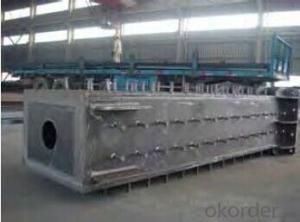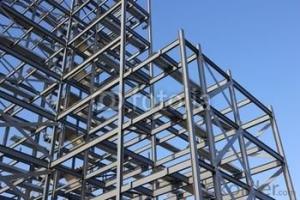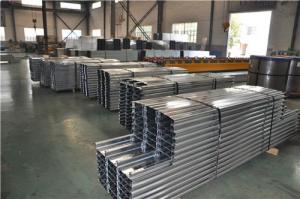High Class Steel-Work made in China
- Loading Port:
- China Main Port
- Payment Terms:
- TT OR LC
- Min Order Qty:
- -
- Supply Capability:
- -
OKorder Service Pledge
Quality Product, Order Online Tracking, Timely Delivery
OKorder Financial Service
Credit Rating, Credit Services, Credit Purchasing
You Might Also Like
Steel Structure
Description:
1.Length of the welding withnot indication, full welding should be applied
2.Seam without indication is fillet weld, height is 0.75t
3.The cutting angle without indication, radius R=30
4.Cutting angle not specified should be
5.The diameter of the hole for the bolt if not specified, D=22

Project Reference:
Area: 17,000m2
Steel Structure Quantity: 2,700ton
Color-Steel Plate Area: 29,670ton
Column Height: 32m
Weight of Per Column: 25ton
Crane Tonnage: 300ton
Total Cost: 25,080,000RMB
Duration: 150days

- Q:What are the design considerations for steel structures in mixed-use developments?
- Some key design considerations for steel structures in mixed-use developments include the need for versatility in accommodating various functions and uses, ensuring structural stability and load-bearing capacity for multiple floors and different types of spaces, incorporating efficient fire protection measures, providing adequate acoustic and thermal insulation, integrating sustainable design principles, and allowing for future flexibility and adaptability to accommodate changes in occupancy or use.
- Q:How are steel structures designed for sports stadiums and arenas?
- Steel structures for sports stadiums and arenas are designed through a rigorous engineering process that takes into account various factors such as load-bearing capacity, durability, aesthetics, and functionality. Designers analyze the specific requirements of the venue, including seating capacity, roof design, and desired architectural features. Using computer-aided design (CAD) software and advanced structural analysis techniques, they develop a detailed plan that ensures the steel structure can withstand the forces imposed by the building's use, such as wind, snow, and seismic loads. The design also considers factors like material selection, fabrication methods, and construction processes to optimize efficiency and cost-effectiveness. Overall, the design of steel structures for sports stadiums and arenas involves a comprehensive approach that prioritizes safety, functionality, and architectural vision.
- Q:What is the cost of a steel structure compared to other construction materials?
- The cost of a steel structure can vary depending on various factors such as the size, design complexity, location, and current market conditions. However, in general, steel structures tend to be more cost-effective compared to other construction materials like concrete or wood. Steel is a highly durable and versatile material, allowing for faster construction times and reduced labor costs. Additionally, its strength-to-weight ratio makes it more efficient in terms of material usage, resulting in potential cost savings. Overall, while the cost of a steel structure can vary, it is often a competitive option when compared to other construction materials.
- Q:What is the role of steel in insulation and energy efficiency?
- Steel's contribution to insulation and energy efficiency is paramount, displaying its significance in various ways. Initially, steel finds common usage in insulated panels and building materials, effectively creating structures that are both airtight and well-insulated. These panels, composed of steel sheets sandwiching insulation material, exhibit exceptional resistance to heat transfer, ensuring a comfortable temperature within the building and reducing the necessity for excessive heating or cooling, consequently conserving energy. Furthermore, steel's utilization extends to the manufacturing of energy-efficient appliances and equipment. For example, steel is frequently employed in the production of refrigerators, freezers, and HVAC systems designed to be energy-efficient. Its durability and impressive strength-to-weight ratio make it a perfect material for constructing these appliances, guaranteeing their longevity and efficient operation. Additionally, steel's efficient heat conduction capabilities facilitate superior heat exchange within these appliances, ultimately enhancing their energy efficiency. Moreover, steel assumes a crucial role in the development of energy-efficient windows and doors. Steel frames provide the necessary strength and stability for these structures, allowing the installation of double or triple-glazed glass panels. These insulated glass units (IGUs) significantly diminish heat transfer through windows and doors, effectively preventing energy loss and bolstering the overall energy efficiency of buildings. Lastly, steel's application extends to the construction of energy-efficient vehicles. Lightweight steel alloys are employed to decrease the weight of cars, trucks, and other modes of transportation, ultimately leading to improved fuel efficiency. Additionally, steel's high strength and resistance to impact contribute to the safety of vehicles, reducing the risk of accidents and enhancing overall energy efficiency through diminished maintenance and repair requirements. In conclusion, steel assumes a vital role in insulation and energy efficiency by facilitating the construction of well-insulated structures, energy-efficient appliances, windows, doors, and vehicles. Its thermal properties, durability, and strength make it an indispensable material for the creation of energy-efficient solutions, effectively conserving energy and minimizing environmental impact.
- Q:What are the common challenges faced during the construction of steel structures?
- There are several common challenges that can be encountered during the construction of steel structures. These challenges include: 1. Design complexity: Steel structures often involve complex design calculations and detailing. The intricate design requirements can pose challenges in terms of ensuring structural integrity, ensuring proper load distribution, and accommodating different architectural and functional requirements. 2. Material handling and transportation: Steel structures require large quantities of steel components, which can be heavy and difficult to handle and transport. Efficient logistics planning is crucial to ensure timely delivery of materials to the construction site, as well as proper storage and handling of steel components on-site. 3. Welding and fabrication: Steel structures often require welding and fabrication processes, which can be complex and time-consuming. Proper training and expertise are necessary to ensure high-quality welds and fabrication, as any defects can compromise the structural integrity of the steel components. 4. Weather conditions: Construction of steel structures can be significantly affected by adverse weather conditions such as high winds, extreme temperatures, and heavy rainfall. These weather conditions can hamper construction progress, increase safety risks, and require additional measures to protect the steel components from corrosion or damage. 5. Site access and space limitations: Steel structures are often constructed in urban areas or on sites with limited access and space. This can pose challenges in terms of logistics, material storage, and equipment maneuverability. Careful planning and coordination are necessary to optimize construction processes and minimize disruptions to neighboring properties or infrastructure. 6. Coordination with other trades: Steel structures are typically part of a larger construction project that involves multiple trades and disciplines. Effective coordination and communication with other contractors, architects, engineers, and subcontractors are essential to ensure seamless integration of steel components with other building systems, such as electrical, mechanical, and plumbing, to avoid conflicts or delays. 7. Quality control and inspections: Ensuring the quality of steel structures requires strict adherence to industry standards and codes. Regular inspections and quality control measures are necessary to verify the integrity of the steel components, welding, and fabrication processes. Any deficiencies or deviations need to be addressed promptly to maintain safety and structural soundness. Overall, the construction of steel structures requires careful planning, coordination, and expertise to overcome these common challenges. By addressing these challenges effectively, construction projects can be completed successfully, resulting in safe, durable, and aesthetically pleasing steel structures.
- Q:How are steel structures used in exhibition and convention centers?
- Steel structures are extensively used in exhibition and convention centers due to their versatility, strength, and cost-effectiveness. They are used to create large open spaces, support heavy loads, and provide flexibility for layout changes. Steel beams and columns are used to construct the framework of these buildings, allowing for the creation of expansive exhibition halls, conference rooms, and auditoriums without the need for excessive interior support. Additionally, steel structures offer the ability to incorporate large windows and glass facades, enhancing natural light and creating a visually appealing environment for attendees. Overall, steel structures play a crucial role in providing the necessary infrastructure for hosting successful exhibitions and conventions.
- Q:What are the different types of steel corrosion protection systems used in structures?
- There are several different types of steel corrosion protection systems that are commonly used in structures. These systems are designed to prevent or minimize the corrosion of steel, which can lead to structural deterioration and failure over time. One of the most common types of corrosion protection systems is the application of protective coatings. These coatings act as a barrier between the steel and the surrounding environment, preventing moisture and other corrosive agents from coming into contact with the metal. There are various types of protective coatings available, including epoxy, polyurethane, and zinc-rich coatings. These coatings can be applied through processes such as painting, spraying, or dipping, and they provide excellent corrosion resistance. Another type of corrosion protection system is cathodic protection. This method involves connecting the steel to a sacrificial anode, which is a more reactive metal that will corrode in place of the steel. This process creates a galvanic cell, where the anode becomes the site of corrosion instead of the steel. Cathodic protection is commonly used in areas where the steel is exposed to high levels of moisture or in structures that are immersed in water, such as pipelines, storage tanks, and offshore structures. In addition to protective coatings and cathodic protection, other corrosion protection systems include galvanizing and metal spraying. Galvanizing involves coating the steel with a layer of zinc through a hot-dip process. The zinc acts as a sacrificial anode, protecting the steel from corrosion. Metal spraying, on the other hand, involves the application of a layer of molten metal onto the steel surface. This creates a protective barrier that prevents corrosion. Furthermore, proper design and maintenance practices can also contribute to the corrosion protection of steel structures. This may involve ensuring adequate drainage to prevent the accumulation of moisture, regular inspection and cleaning of the steel surfaces, and the use of corrosion inhibitors in certain environments. Overall, the selection of a particular corrosion protection system depends on factors such as the environmental conditions, the expected service life of the structure, and the desired level of corrosion resistance. By implementing the appropriate corrosion protection system, the longevity and structural integrity of steel structures can be significantly improved.
- Q:How are steel structures designed to resist fire and heat?
- Steel structures are designed to resist fire and heat through several measures. Firstly, fire-resistant coatings are applied to the steel surfaces, forming a protective layer that delays the transfer of heat to the steel structure. Additionally, fireproof insulation materials are used to fill cavities and spaces within the structure, preventing heat from penetrating or spreading. Steel members are also designed to have sufficient size and thickness, ensuring they retain their structural integrity even when exposed to high temperatures. Lastly, fire-resistant barriers, such as fire doors and fire-resistant walls, are incorporated into the design to compartmentalize the structure and prevent the spread of fire.
- Q:How are steel structures designed to be resistant to internal and external forces?
- Steel structures are engineered to exhibit exceptional resistance to both internal and external forces by employing meticulous design techniques and harnessing the advantageous properties of the material. To commence, steel possesses remarkable durability and strength, rendering it an optimal choice for construction purposes. Its high tensile strength enables it to endure substantial loads and forces without distorting or fracturing. This inherent fortitude empowers steel structures to effectively combat both internal and external forces. Regarding internal forces, steel structures are meticulously designed to handle various types of stress and strain that may transpire within the structure itself. These internal forces encompass compression (converging forces), tension (diverging forces), shear (parallel forces acting in opposite directions), and bending (forces that cause the structure to contort or flex). By considering the anticipated loads acting on the structure, engineers can determine the appropriate dimensions and configuration of steel components to withstand these internal forces. Additionally, steel structures are engineered to counteract external forces such as wind, earthquakes, and snow loads. Wind forces can exert substantial pressure on a structure, particularly in regions prone to high winds. Steel structures are designed with suitable bracing and cross-sections to counterbalance these forces, thereby ensuring the stability and integrity of the structure even under extreme conditions. Similarly, steel structures are fortified to endure earthquakes, which subject buildings to both vertical and lateral forces. Engineers account for the seismic activity of the area and design the structure accordingly, incorporating robust connections, flexible joints, and damping systems to absorb and dissipate the energy generated by the earthquake. Furthermore, steel structures must be designed to withstand the external force of snow loads, particularly in regions with heavy snowfall. Engineers consider the weight of the snow and engineer the structure with ample strength and support to prevent collapse or damage. In conclusion, steel structures are meticulously designed to possess resistance against both internal and external forces. By combining the inherent strength of steel with precise engineering techniques and careful consideration of the anticipated loads and forces acting on the structure, engineers can create sturdy and enduring steel structures capable of withstanding a wide array of conditions and forces.
- Q:How are steel structures designed to accommodate exterior cladding systems?
- Steel structures are designed to accommodate exterior cladding systems by providing a strong and stable framework that can support the weight and load of the cladding materials. The steel framework is designed with specific connection points and structural elements to ensure the cladding system can be securely attached and supported. Additionally, the design takes into consideration factors such as wind loads, thermal expansion, and other environmental conditions to ensure the cladding system remains durable and functional over time.
1. Manufacturer Overview |
|
|---|---|
| Location | |
| Year Established | |
| Annual Output Value | |
| Main Markets | |
| Company Certifications | |
2. Manufacturer Certificates |
|
|---|---|
| a) Certification Name | |
| Range | |
| Reference | |
| Validity Period | |
3. Manufacturer Capability |
|
|---|---|
| a)Trade Capacity | |
| Nearest Port | |
| Export Percentage | |
| No.of Employees in Trade Department | |
| Language Spoken: | |
| b)Factory Information | |
| Factory Size: | |
| No. of Production Lines | |
| Contract Manufacturing | |
| Product Price Range | |
Send your message to us
High Class Steel-Work made in China
- Loading Port:
- China Main Port
- Payment Terms:
- TT OR LC
- Min Order Qty:
- -
- Supply Capability:
- -
OKorder Service Pledge
Quality Product, Order Online Tracking, Timely Delivery
OKorder Financial Service
Credit Rating, Credit Services, Credit Purchasing
Similar products
New products
Hot products


























